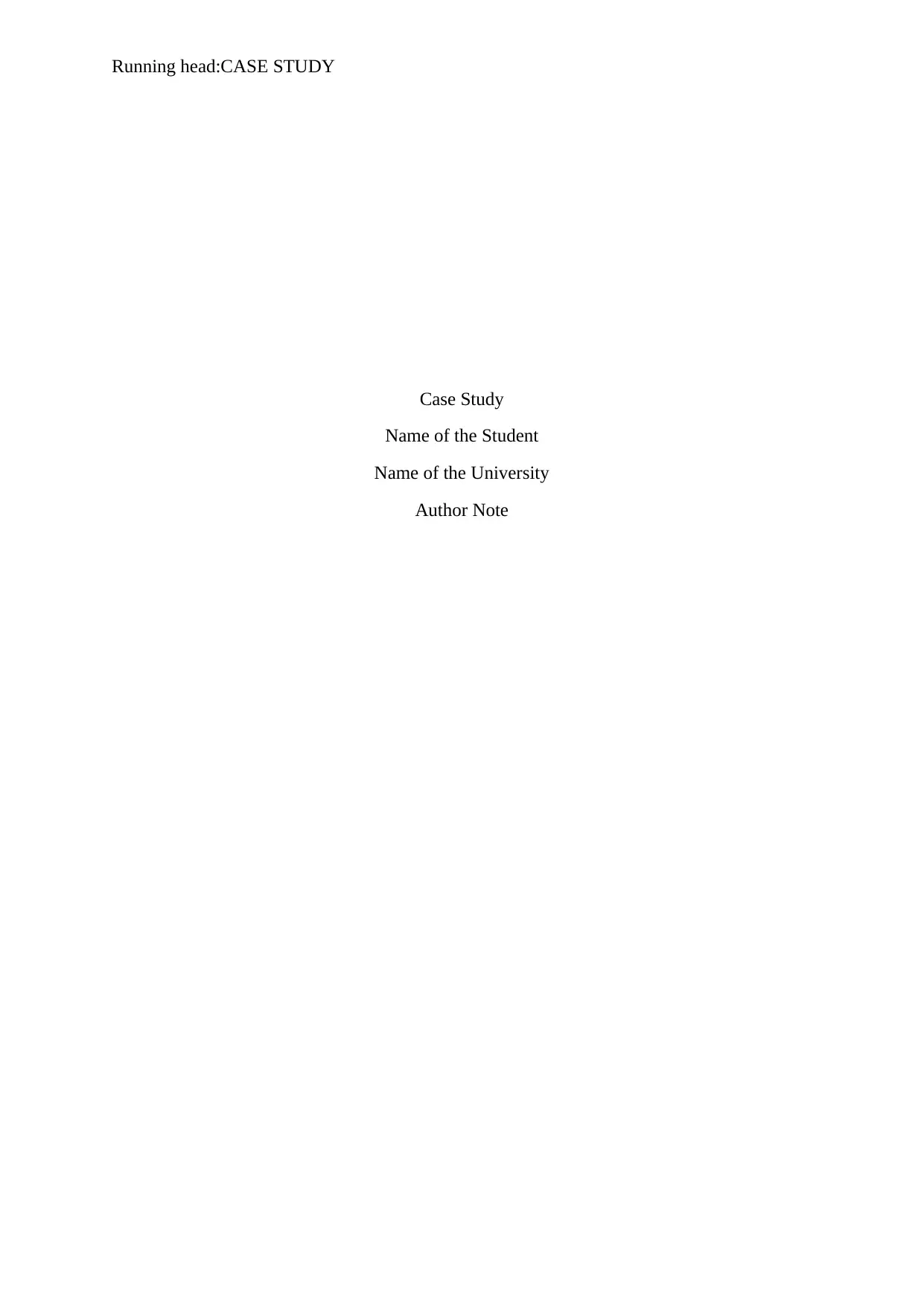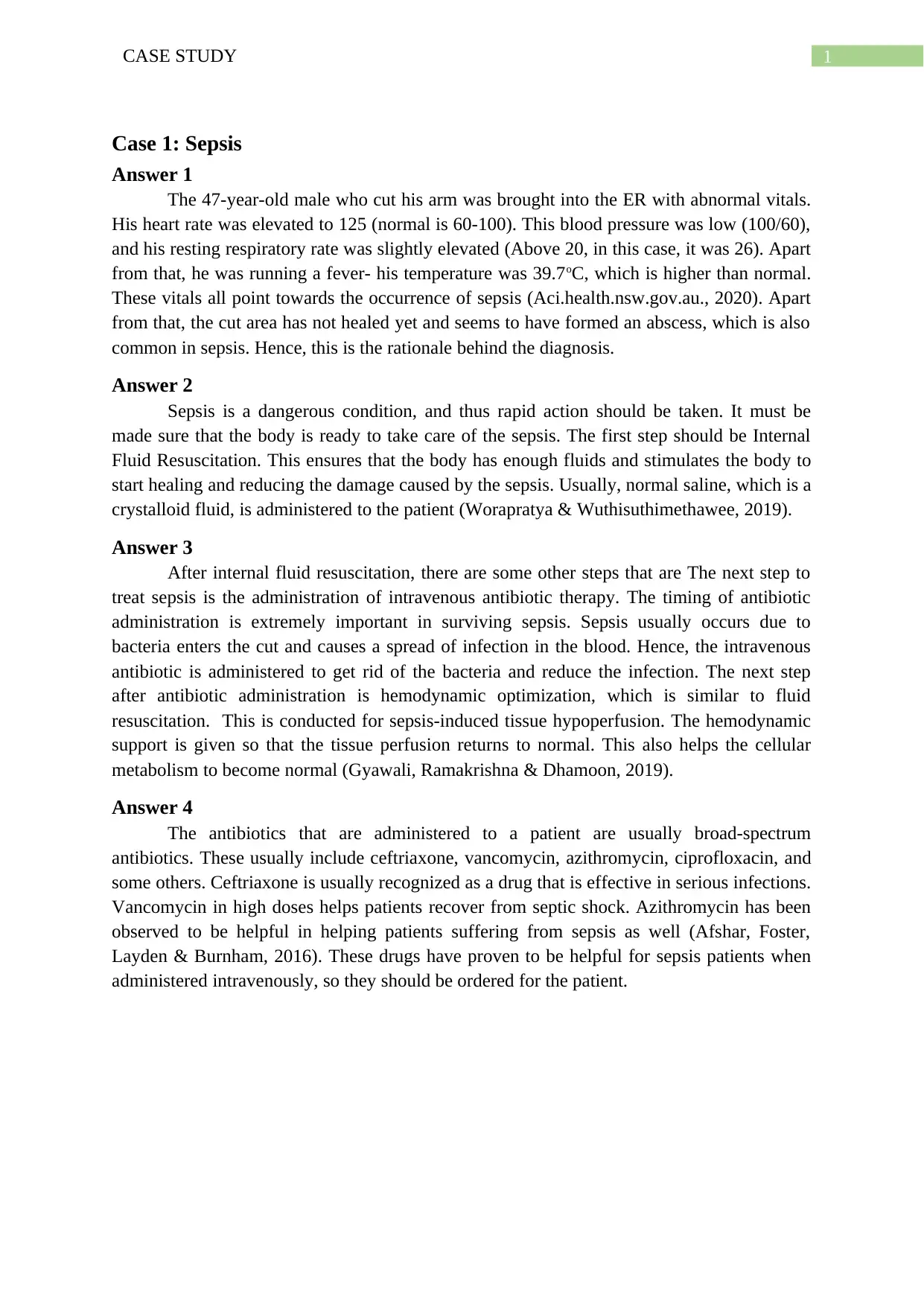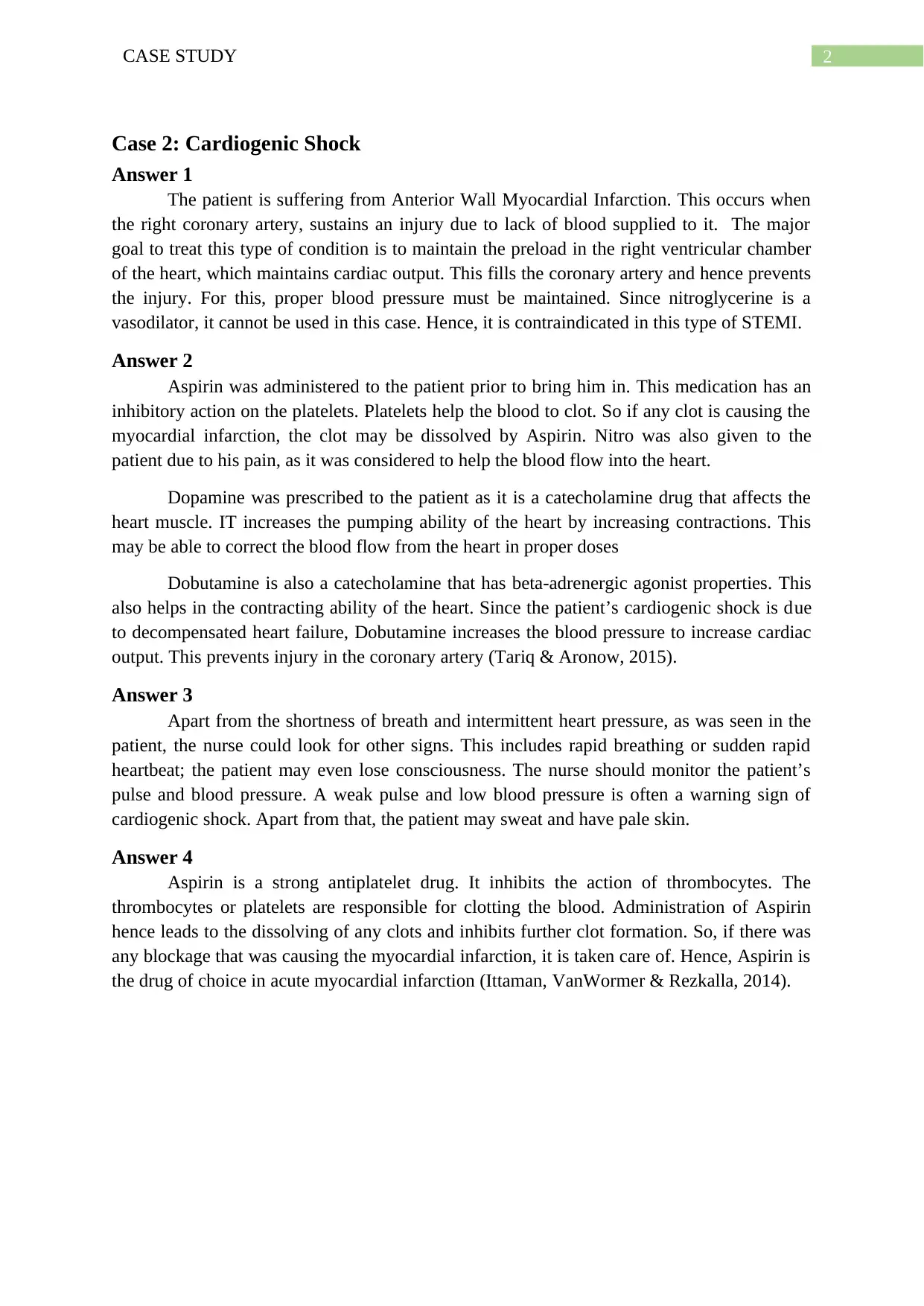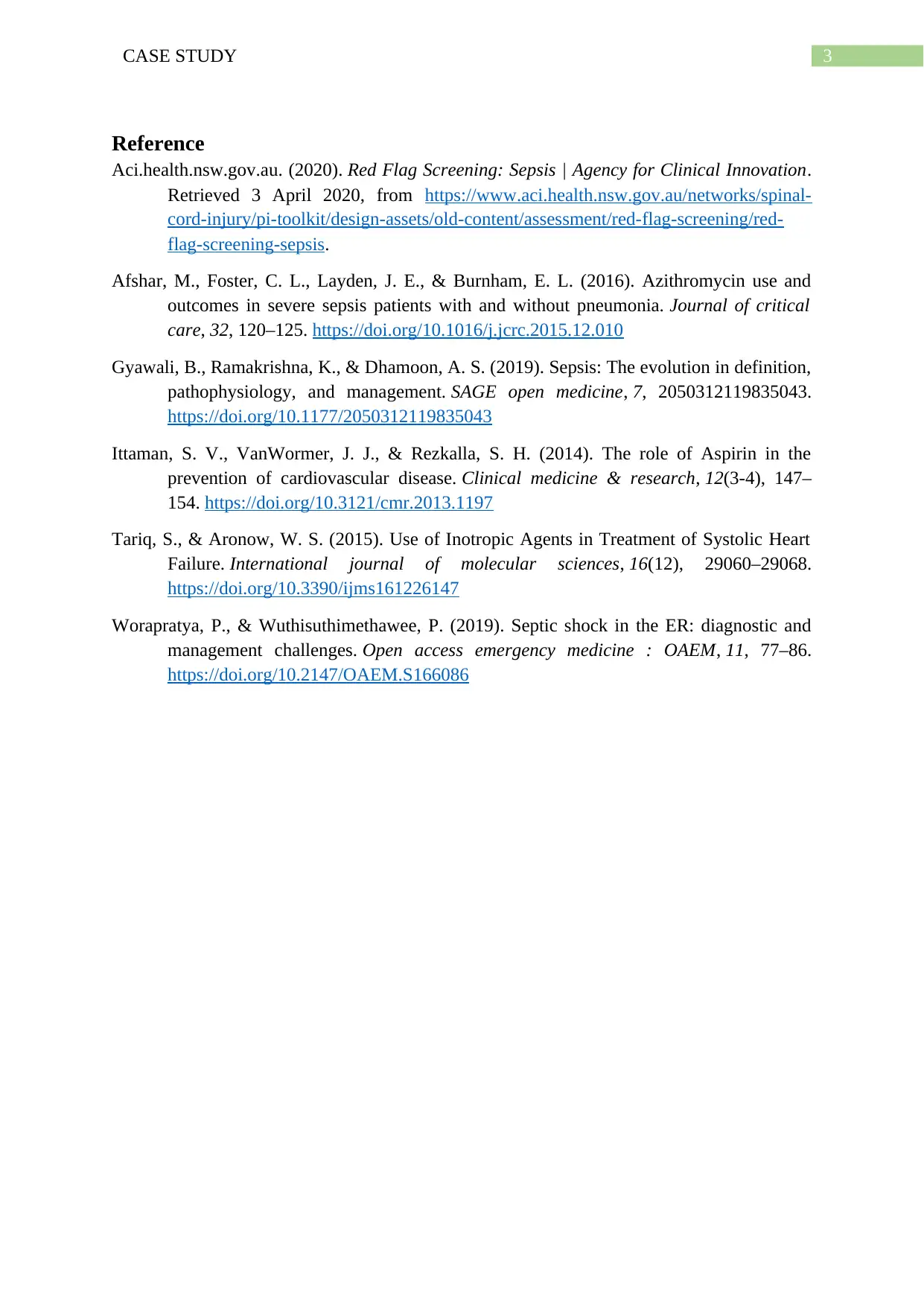Case Study: Medical Analysis of Sepsis and Cardiogenic Shock Scenarios
VerifiedAdded on 2022/09/13
|4
|1190
|9
Case Study
AI Summary
This case study presents two medical scenarios: sepsis and cardiogenic shock. The first case involves a 47-year-old male with a cut arm exhibiting symptoms of sepsis, including elevated heart rate, low blood pressure, fever, and an abscess. The analysis covers diagnosis based on vital signs and the rationale behind it. The treatment section details internal fluid resuscitation, intravenous antibiotic therapy (ceftriaxone, vancomycin, azithromycin), and hemodynamic optimization. The second case focuses on a patient suffering from Anterior Wall Myocardial Infarction and cardiogenic shock. It explains the contraindication of nitroglycerine, the role of aspirin, and the use of dopamine and dobutamine. The study also highlights other signs a nurse should monitor, such as rapid breathing and weak pulse. The role of aspirin as an antiplatelet drug is also emphasized. The assignment provides detailed explanations of the diagnosis and treatment options for both conditions, supported by cited references.

Running head:CASE STUDY
Case Study
Name of the Student
Name of the University
Author Note
Case Study
Name of the Student
Name of the University
Author Note
Paraphrase This Document
Need a fresh take? Get an instant paraphrase of this document with our AI Paraphraser

1CASE STUDY
Case 1: Sepsis
Answer 1
The 47-year-old male who cut his arm was brought into the ER with abnormal vitals.
His heart rate was elevated to 125 (normal is 60-100). This blood pressure was low (100/60),
and his resting respiratory rate was slightly elevated (Above 20, in this case, it was 26). Apart
from that, he was running a fever- his temperature was 39.7oC, which is higher than normal.
These vitals all point towards the occurrence of sepsis (Aci.health.nsw.gov.au., 2020). Apart
from that, the cut area has not healed yet and seems to have formed an abscess, which is also
common in sepsis. Hence, this is the rationale behind the diagnosis.
Answer 2
Sepsis is a dangerous condition, and thus rapid action should be taken. It must be
made sure that the body is ready to take care of the sepsis. The first step should be Internal
Fluid Resuscitation. This ensures that the body has enough fluids and stimulates the body to
start healing and reducing the damage caused by the sepsis. Usually, normal saline, which is a
crystalloid fluid, is administered to the patient (Worapratya & Wuthisuthimethawee, 2019).
Answer 3
After internal fluid resuscitation, there are some other steps that are The next step to
treat sepsis is the administration of intravenous antibiotic therapy. The timing of antibiotic
administration is extremely important in surviving sepsis. Sepsis usually occurs due to
bacteria enters the cut and causes a spread of infection in the blood. Hence, the intravenous
antibiotic is administered to get rid of the bacteria and reduce the infection. The next step
after antibiotic administration is hemodynamic optimization, which is similar to fluid
resuscitation. This is conducted for sepsis-induced tissue hypoperfusion. The hemodynamic
support is given so that the tissue perfusion returns to normal. This also helps the cellular
metabolism to become normal (Gyawali, Ramakrishna & Dhamoon, 2019).
Answer 4
The antibiotics that are administered to a patient are usually broad-spectrum
antibiotics. These usually include ceftriaxone, vancomycin, azithromycin, ciprofloxacin, and
some others. Ceftriaxone is usually recognized as a drug that is effective in serious infections.
Vancomycin in high doses helps patients recover from septic shock. Azithromycin has been
observed to be helpful in helping patients suffering from sepsis as well (Afshar, Foster,
Layden & Burnham, 2016). These drugs have proven to be helpful for sepsis patients when
administered intravenously, so they should be ordered for the patient.
Case 1: Sepsis
Answer 1
The 47-year-old male who cut his arm was brought into the ER with abnormal vitals.
His heart rate was elevated to 125 (normal is 60-100). This blood pressure was low (100/60),
and his resting respiratory rate was slightly elevated (Above 20, in this case, it was 26). Apart
from that, he was running a fever- his temperature was 39.7oC, which is higher than normal.
These vitals all point towards the occurrence of sepsis (Aci.health.nsw.gov.au., 2020). Apart
from that, the cut area has not healed yet and seems to have formed an abscess, which is also
common in sepsis. Hence, this is the rationale behind the diagnosis.
Answer 2
Sepsis is a dangerous condition, and thus rapid action should be taken. It must be
made sure that the body is ready to take care of the sepsis. The first step should be Internal
Fluid Resuscitation. This ensures that the body has enough fluids and stimulates the body to
start healing and reducing the damage caused by the sepsis. Usually, normal saline, which is a
crystalloid fluid, is administered to the patient (Worapratya & Wuthisuthimethawee, 2019).
Answer 3
After internal fluid resuscitation, there are some other steps that are The next step to
treat sepsis is the administration of intravenous antibiotic therapy. The timing of antibiotic
administration is extremely important in surviving sepsis. Sepsis usually occurs due to
bacteria enters the cut and causes a spread of infection in the blood. Hence, the intravenous
antibiotic is administered to get rid of the bacteria and reduce the infection. The next step
after antibiotic administration is hemodynamic optimization, which is similar to fluid
resuscitation. This is conducted for sepsis-induced tissue hypoperfusion. The hemodynamic
support is given so that the tissue perfusion returns to normal. This also helps the cellular
metabolism to become normal (Gyawali, Ramakrishna & Dhamoon, 2019).
Answer 4
The antibiotics that are administered to a patient are usually broad-spectrum
antibiotics. These usually include ceftriaxone, vancomycin, azithromycin, ciprofloxacin, and
some others. Ceftriaxone is usually recognized as a drug that is effective in serious infections.
Vancomycin in high doses helps patients recover from septic shock. Azithromycin has been
observed to be helpful in helping patients suffering from sepsis as well (Afshar, Foster,
Layden & Burnham, 2016). These drugs have proven to be helpful for sepsis patients when
administered intravenously, so they should be ordered for the patient.

2CASE STUDY
Case 2: Cardiogenic Shock
Answer 1
The patient is suffering from Anterior Wall Myocardial Infarction. This occurs when
the right coronary artery, sustains an injury due to lack of blood supplied to it. The major
goal to treat this type of condition is to maintain the preload in the right ventricular chamber
of the heart, which maintains cardiac output. This fills the coronary artery and hence prevents
the injury. For this, proper blood pressure must be maintained. Since nitroglycerine is a
vasodilator, it cannot be used in this case. Hence, it is contraindicated in this type of STEMI.
Answer 2
Aspirin was administered to the patient prior to bring him in. This medication has an
inhibitory action on the platelets. Platelets help the blood to clot. So if any clot is causing the
myocardial infarction, the clot may be dissolved by Aspirin. Nitro was also given to the
patient due to his pain, as it was considered to help the blood flow into the heart.
Dopamine was prescribed to the patient as it is a catecholamine drug that affects the
heart muscle. IT increases the pumping ability of the heart by increasing contractions. This
may be able to correct the blood flow from the heart in proper doses
Dobutamine is also a catecholamine that has beta-adrenergic agonist properties. This
also helps in the contracting ability of the heart. Since the patient’s cardiogenic shock is due
to decompensated heart failure, Dobutamine increases the blood pressure to increase cardiac
output. This prevents injury in the coronary artery (Tariq & Aronow, 2015).
Answer 3
Apart from the shortness of breath and intermittent heart pressure, as was seen in the
patient, the nurse could look for other signs. This includes rapid breathing or sudden rapid
heartbeat; the patient may even lose consciousness. The nurse should monitor the patient’s
pulse and blood pressure. A weak pulse and low blood pressure is often a warning sign of
cardiogenic shock. Apart from that, the patient may sweat and have pale skin.
Answer 4
Aspirin is a strong antiplatelet drug. It inhibits the action of thrombocytes. The
thrombocytes or platelets are responsible for clotting the blood. Administration of Aspirin
hence leads to the dissolving of any clots and inhibits further clot formation. So, if there was
any blockage that was causing the myocardial infarction, it is taken care of. Hence, Aspirin is
the drug of choice in acute myocardial infarction (Ittaman, VanWormer & Rezkalla, 2014).
Case 2: Cardiogenic Shock
Answer 1
The patient is suffering from Anterior Wall Myocardial Infarction. This occurs when
the right coronary artery, sustains an injury due to lack of blood supplied to it. The major
goal to treat this type of condition is to maintain the preload in the right ventricular chamber
of the heart, which maintains cardiac output. This fills the coronary artery and hence prevents
the injury. For this, proper blood pressure must be maintained. Since nitroglycerine is a
vasodilator, it cannot be used in this case. Hence, it is contraindicated in this type of STEMI.
Answer 2
Aspirin was administered to the patient prior to bring him in. This medication has an
inhibitory action on the platelets. Platelets help the blood to clot. So if any clot is causing the
myocardial infarction, the clot may be dissolved by Aspirin. Nitro was also given to the
patient due to his pain, as it was considered to help the blood flow into the heart.
Dopamine was prescribed to the patient as it is a catecholamine drug that affects the
heart muscle. IT increases the pumping ability of the heart by increasing contractions. This
may be able to correct the blood flow from the heart in proper doses
Dobutamine is also a catecholamine that has beta-adrenergic agonist properties. This
also helps in the contracting ability of the heart. Since the patient’s cardiogenic shock is due
to decompensated heart failure, Dobutamine increases the blood pressure to increase cardiac
output. This prevents injury in the coronary artery (Tariq & Aronow, 2015).
Answer 3
Apart from the shortness of breath and intermittent heart pressure, as was seen in the
patient, the nurse could look for other signs. This includes rapid breathing or sudden rapid
heartbeat; the patient may even lose consciousness. The nurse should monitor the patient’s
pulse and blood pressure. A weak pulse and low blood pressure is often a warning sign of
cardiogenic shock. Apart from that, the patient may sweat and have pale skin.
Answer 4
Aspirin is a strong antiplatelet drug. It inhibits the action of thrombocytes. The
thrombocytes or platelets are responsible for clotting the blood. Administration of Aspirin
hence leads to the dissolving of any clots and inhibits further clot formation. So, if there was
any blockage that was causing the myocardial infarction, it is taken care of. Hence, Aspirin is
the drug of choice in acute myocardial infarction (Ittaman, VanWormer & Rezkalla, 2014).
⊘ This is a preview!⊘
Do you want full access?
Subscribe today to unlock all pages.

Trusted by 1+ million students worldwide

3CASE STUDY
Reference
Aci.health.nsw.gov.au. (2020). Red Flag Screening: Sepsis | Agency for Clinical Innovation.
Retrieved 3 April 2020, from https://www.aci.health.nsw.gov.au/networks/spinal-
cord-injury/pi-toolkit/design-assets/old-content/assessment/red-flag-screening/red-
flag-screening-sepsis.
Afshar, M., Foster, C. L., Layden, J. E., & Burnham, E. L. (2016). Azithromycin use and
outcomes in severe sepsis patients with and without pneumonia. Journal of critical
care, 32, 120–125. https://doi.org/10.1016/j.jcrc.2015.12.010
Gyawali, B., Ramakrishna, K., & Dhamoon, A. S. (2019). Sepsis: The evolution in definition,
pathophysiology, and management. SAGE open medicine, 7, 2050312119835043.
https://doi.org/10.1177/2050312119835043
Ittaman, S. V., VanWormer, J. J., & Rezkalla, S. H. (2014). The role of Aspirin in the
prevention of cardiovascular disease. Clinical medicine & research, 12(3-4), 147–
154. https://doi.org/10.3121/cmr.2013.1197
Tariq, S., & Aronow, W. S. (2015). Use of Inotropic Agents in Treatment of Systolic Heart
Failure. International journal of molecular sciences, 16(12), 29060–29068.
https://doi.org/10.3390/ijms161226147
Worapratya, P., & Wuthisuthimethawee, P. (2019). Septic shock in the ER: diagnostic and
management challenges. Open access emergency medicine : OAEM, 11, 77–86.
https://doi.org/10.2147/OAEM.S166086
Reference
Aci.health.nsw.gov.au. (2020). Red Flag Screening: Sepsis | Agency for Clinical Innovation.
Retrieved 3 April 2020, from https://www.aci.health.nsw.gov.au/networks/spinal-
cord-injury/pi-toolkit/design-assets/old-content/assessment/red-flag-screening/red-
flag-screening-sepsis.
Afshar, M., Foster, C. L., Layden, J. E., & Burnham, E. L. (2016). Azithromycin use and
outcomes in severe sepsis patients with and without pneumonia. Journal of critical
care, 32, 120–125. https://doi.org/10.1016/j.jcrc.2015.12.010
Gyawali, B., Ramakrishna, K., & Dhamoon, A. S. (2019). Sepsis: The evolution in definition,
pathophysiology, and management. SAGE open medicine, 7, 2050312119835043.
https://doi.org/10.1177/2050312119835043
Ittaman, S. V., VanWormer, J. J., & Rezkalla, S. H. (2014). The role of Aspirin in the
prevention of cardiovascular disease. Clinical medicine & research, 12(3-4), 147–
154. https://doi.org/10.3121/cmr.2013.1197
Tariq, S., & Aronow, W. S. (2015). Use of Inotropic Agents in Treatment of Systolic Heart
Failure. International journal of molecular sciences, 16(12), 29060–29068.
https://doi.org/10.3390/ijms161226147
Worapratya, P., & Wuthisuthimethawee, P. (2019). Septic shock in the ER: diagnostic and
management challenges. Open access emergency medicine : OAEM, 11, 77–86.
https://doi.org/10.2147/OAEM.S166086
1 out of 4
Related Documents
Your All-in-One AI-Powered Toolkit for Academic Success.
+13062052269
info@desklib.com
Available 24*7 on WhatsApp / Email
![[object Object]](/_next/static/media/star-bottom.7253800d.svg)
Unlock your academic potential
Copyright © 2020–2025 A2Z Services. All Rights Reserved. Developed and managed by ZUCOL.




